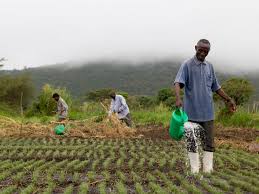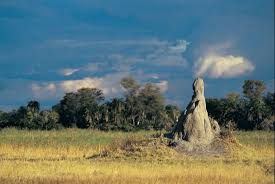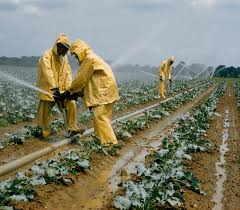The last article discussed the ways of improving agriculture with particular reference to Nigeria. The article highlighted sixteen (16) solutions to the twenty (20) problems affecting the development of agriculture.
The problems highlighted include: land tenure system, infrastructural facilities, finances, transportation, communication, storage facilities, processing facilities, illiteracy level of farmers, extension services, tools and farm machines.
Government policies and programmes, uncertainties, farm inputs, attitudes towards farming, environmental degradation, customs, poverty, and farmers’ organisations. In this article, the effects of environmental factors on agricultural production will be discussed.
Read Also: How To Get Rid of Honey Bees Without Killing Them
Agriculture and the Natural Vegetation of Nigeria

The various vegetation or ecological zones in Nigeria are determined by the amount and distribution of rainfall. The amount and distribution of rainfall vary from the southern coastal area to the far northern part of the country, giving rise to the various vegetation zones.
It is necessary for farmers to know that the growth of all types of crop plants is influenced by the amount and distribution of annual rainfall. This explains why the vegetation of Nigeria varies when travelling from the southern part of the country to the northern part.
It is also important to note that the distribution of annual rainfall influences the type of animal husbandry that can be practised.
Nigerian vegetation can be grouped into two major zones: forest zone and savannah zone.
Forest Zone and Its Agricultural Features
The forest zone can be subdivided into two major parts: mangrove swamp forest and rain forest.
1. Mangrove Swamp Forest and Its Agricultural Limitations
The mangrove swamp forest occurs around the southern coastal areas of Nigeria. This area is characterised by heavy rainfall, high humidity, and swampy saline and water-logged soil.
The vegetation of the area is generally dominated by trees that can survive under water-logged conditions. Most of the trees belong to two major species—Rhizophora spp and Avicennia spp. These groups of plants can survive saline and water-logged conditions by means of their pneumatophores (breathing roots).
Most of the farming activities are limited to fishing only. The species of fish that can survive under saltwater conditions are found in the area. No other serious farming activities are carried out in this zone.
Immediately after the mangrove swamp forest is the freshwater swamp. This zone shares similar conditions with the mangrove except that the water is fresh and not salty. Freshwater swamp is characterised by the presence of Raphia species. The major farming activity in this area is fishing.
2. Rainforest and Its Agricultural Potentials
There is heavy rainfall and high humidity in the rainforest. However, the amount is less than that of swamp forests. Unlike the mangrove swamp forest, the soil is in most cases well drained.
Annual rainfall is usually between 1,300mm and 3,500mm. The rain is not only heavy but well distributed throughout the year.
Some of the forest trees found in this zone include mahogany and iroko. The thick forest provides timber but makes farming operations difficult and laborious. Farm mechanisation is generally difficult.
The zone supports a number of tree crops. The main crops are oil palm, cocoa, rubber, kola nut, etc. The forest in this zone serves as vegetative cover and helps to build up the soil through the dropping of the leaves.
Other crops found in this zone include plantain, banana, coconut, yam, cassava, sweet potatoes, and maize. The only livestock that can thrive well in this zone is poultry.
Ruminant animals, especially cattle, are not popular in this zone because of the absence of natural grassland, difficulty in growing pasture, and high tsetse fly infestation.
Savannah Zone and Its Agricultural Importance

Savannah zone is subdivided into four zones and they include derived savannah, guinea savannah, Sudan savannah, and Sahel savannah. The savannah is dominated by grasses with few scattered trees.
1. Derived Savannah and Its Agricultural Characteristics
Derived savannah occurs between the borders of forest and savannah zones. It originally belongs to the forest zone. The forest is converted to grassland as a result of human activities such as over-cultivation, over-burning, settlement, etc.
The annual rainfall in this zone is between 1000mm to 1500mm. The tree species include Albizia spp, Sterculia spp, Parkia spp. Grasses found in this zone include Andropogon spp, Panicum spp, Pennisetum spp, and Paspalum spp.
The main crops of this area include cassava, yam, maize, cowpea, pigeon pea, groundnut, etc.
2. Guinea Savannah and Its Contribution to Crop and Livestock Farming
Guinea savannah zone is the most extensive zone. It occupies almost half of the area of Nigeria and it occurs within the middle belt of the country. The zone is divided into two—southern guinea savannah and northern guinea savannah.
The southern guinea savannah has annual rainfall of between 1000mm and 1500mm. The length of the dry season is about five to six months. The production of livestock in this area is high. All trees and grasses found in derived savannah are also found in this area.
The northern guinea savannah is the part of guinea savannah found mostly above rivers Niger and Benue. The annual rainfall in this area is about 1000mm.
The major vegetation in this area is tall grasses which include Andropogon spp, Pennisetum spp, Hyparrhenia spp, etc. Few trees like Combretum spp, Terminalia spp, Parkia spp, etc. are also found there.
The guinea savannah is of relatively high importance in agriculture in Nigeria. A number of food crops are grown such as cotton, sugarcane, groundnut, cassava, yam, cocoyam, sweet potatoes, cowpea, pigeon pea, bambara nut, etc.
3. Sudan Savannah and Its Role in Livestock and Crop Production
The Sudan savannah lies immediately above the guinea savannah. The annual rainfall in this zone is generally below 1000mm. The dry season is fairly long.
The vegetation of this zone is made up of trees like Acacia spp, Combretum spp, Butyrospermum spp, etc. Grasses found in this zone include Andropogon spp, Hyparrhenia spp, Brachiaria spp, Eragrostis spp, and Pennisetum spp, etc.
This low grassland zone is free from tsetse fly and so provides a good environment for livestock production. The livestock found in this zone are cattle, sheep, goats, etc. The soil is a loose sandy-loam suitable for the production of groundnut, millet, sorghum, and cotton.
4. Sahel Savannah and Its Significance in Pastoral Agriculture
Sahel savannah is the last zone, located at the extreme northern part of the country. It is a very dry type of savannah with an annual rainfall of less than 750mm. The rainy season lasts between three to four months. The soil is loose with sparse vegetation. Grazing occurs mainly around the fadama area of the zone. The major livestock production in Nigeria occurs in this zone.
The trees found in this zone are those that withstand drought. Such trees include Adansonia spp, Acacia spp, Bombax spp.
The common grass species are Pennisetum spp, Andropogon spp, etc. It is predominantly a pastoral zone.
Some crop production takes place such as the drought-resistant varieties of millet, sorghum, cotton, and groundnut.
Agriculture and Natural Vegetation of Nigeria
The various vegetation or ecological zones in Nigeria are determined by the amount and distribution of rainfall. The amount and distribution of rainfall vary from the southern coastal areas to the far northern part of the country, giving rise to various vegetation zones.
It is essential for farmers to understand that the growth of all types of crop plants is influenced by the amount and distribution of annual rainfall.
This explains the variation in vegetation across Nigeria, from the southern to the northern regions. It is also important to note that the distribution of annual rainfall influences the types of animal husbandry that can be practiced.
Nigerian vegetation can be grouped into two major zones: the forest zone and the savannah zone.
1. Forest Zone
The forest zone can be subdivided into two major parts: the mangrove swamp forest and the rain forest.
i. Mangrove Swamp Forest
The mangrove swamp forest occurs around Nigeria’s southern coastal areas. This area is characterized by heavy rainfall, high humidity, and swampy saline and waterlogged soil.
The vegetation here is dominated by trees that can survive in waterlogged conditions, most of which belong to two major species: Rhizophora spp and Avicennia spp. These plants can survive saline and waterlogged conditions through their breathing roots called pneumatophores.
Farming activities in this zone are limited to fishing, with species of fish that can survive in saltwater conditions found here. Other farming activities are not common.
Immediately after the mangrove swamp forest is the freshwater swamp, which shares similar conditions with the mangrove zone, except that the water is fresh. The freshwater swamp is characterized by the presence of Raphia spp, and fishing is the major farming activity here.
ii. The Rainforest
The rainforest experiences heavy rainfall and high humidity, although not as much as the swamp forests. The soil here is generally well-drained, and annual rainfall ranges from 1,300mm to 3,500mm, with rain well distributed throughout the year.
Notable tree species in this zone include mahogany and iroko. The thick forest makes farming operations difficult and laborious, and farm mechanization is generally challenging.
This zone supports various tree crops, such as oil palm, cocoa, rubber, and cola nut. Other crops include plantain, banana, coconut, yam, cassava, sweet potatoes, and maize.
Poultry farming thrives in this zone, while ruminant animals, particularly cattle, are less common due to the absence of natural grasslands, difficulties in growing pasture, and high tsetse fly infestation.
2. Savannah Zone
The savannah zone is subdivided into four zones: derived savannah, guinea savannah, sudan savannah, and sahel savannah. The zone is dominated by grasses with few scattered trees.
i. The Derived Savannah
The derived savannah occurs between the borders of the forest and savannah zones. Originally part of the forest zone, it has been converted to grassland due to human activities such as over-cultivation, burning, and settlement.
The annual rainfall in this zone is between 1,000mm and 1,500mm, and tree species include Albizia spp, Sterculia spp, and Parkia spp. The main crops grown here include cassava, yam, maize, cowpea, pigeon pea, and groundnut.
ii. The Guinea Savannah
The guinea savannah is the largest of the savannah zones, occupying almost half of Nigeria’s land area and extending through the middle belt. It is divided into two regions: southern guinea savannah and northern guinea savannah.
The southern guinea savannah experiences annual rainfall between 1,000mm and 1,500mm, with a dry season lasting five to six months. Livestock production is high in this region, and the vegetation is similar to that of the derived savannah.
The northern guinea savannah, located above the Niger and Benue Rivers, receives about 1,000mm of annual rainfall.
Vegetation here includes tall grasses, such as Andropogon spp, Pennisetum spp, and Hipparrhenia spp, with a few trees like Combretum spp, Terninalia spp, and Parkia spp. Common crops include cotton, sugarcane, groundnut, cassava, yam, cocoyam, sweet potatoes, cowpea, pigeon pea, and bambara nut.
iii. Sudan Savannah
Located immediately above the guinea savannah, the sudan savannah has an annual rainfall of less than 1,000mm and a long dry season. Vegetation consists of trees like Acacia spp, Combretum spp, and Butyrospermum spp, and grasses such as Andropogon spp, Hyperrhenia spp, Brachiaria spp, and Eragrostis spp.
The soil is a loose sandy-loam, suitable for crops like groundnut, millet, sorghum, and cotton. This zone is free from tsetse flies, making it ideal for livestock production, especially cattle, sheep, and goats.
iv. Sahel Savannah
The sahel savannah is the last zone, located in the extreme northern part of Nigeria. It is a very dry zone with annual rainfall below 750mm, and the rainy season lasts only three to four months.
The vegetation is sparse, and grazing occurs mainly around the fadama areas. The major trees found here are drought-resistant species like Andosonia spp, Acacia spp, and Bombax spp. Common grass species include Pennisetum spp and Andropogon spp.
This zone is primarily pastoral, and drought-resistant crops like millet, sorghum, cotton, and groundnut are grown.
Read Also: Where Do Honey Bees Nest
Agricultural Environmental Factors

1. Agricultural Meteorology
Meteorology is the study of the atmosphere, including weather patterns. A meteorological station is a location where weather variables are measured and recorded. Some instruments used to measure weather variables include:
i. Thermometer: Measures temperature, indicating the degree of hotness or coldness.
ii. Hygrometer: Measures relative humidity, or the amount of water vapor in the air.
iii. Barometer: Measures atmospheric pressure.
iv. Anemometer: Measures wind speed.
v. Rain Gauge: Measures the amount of rainfall.
The Effects of Climatic Factors on Agriculture
Climatic factors, including temperature, rainfall, solar radiation, and relative humidity, significantly affect agriculture. Together with soil and living organisms, these factors shape the environment in which crops grow and determine agricultural productivity.
1. Temperature
Temperature affects various processes in plants, including pollination, nutrient absorption, photosynthesis, transpiration, respiration, and the movement of food within the plant.
Each crop has a minimum, optimum, and maximum temperature range; if the temperature falls below the minimum or exceeds the maximum, crop growth may be inhibited, or the plants may die. Tropical crops are generally adapted to higher temperatures, typically ranging from 25°C to 33°C.
Irrigation and mulching can help regulate soil temperatures, as water in irrigation is relatively warm and can transfer heat to the soil. Mulching prevents excessive heat from reaching the soil and reduces heat loss during the rainy season.
2. Rainfall
Rainfall plays a crucial role in agriculture as it provides water for crops and livestock. Insufficient or excessive rainfall can harm crops, leading to drought or flooding.
Irrigation systems can mitigate the effects of drought, while techniques such as mulching, crop rotation, and terracing help conserve soil moisture.
3. Sunlight or Solar Radiation
Sunlight provides the energy required for photosynthesis, which is essential for plant growth. The intensity, quality, and duration of sunlight influence crop growth, distribution, and flowering.
Plants respond to day length through photoperiodism, and some plants are adapted to short or long day lengths. Pruning, planting density, and shading can help manage the amount of light plants receive.
Do you have any questions, suggestions, or contributions? If so, please feel free to use the comment box below to share your thoughts. We also encourage you to kindly share this information with others who might benefit from it. Since we can’t reach everyone at once, we truly appreciate your help in spreading the word. Thank you so much for your support and for sharing!
